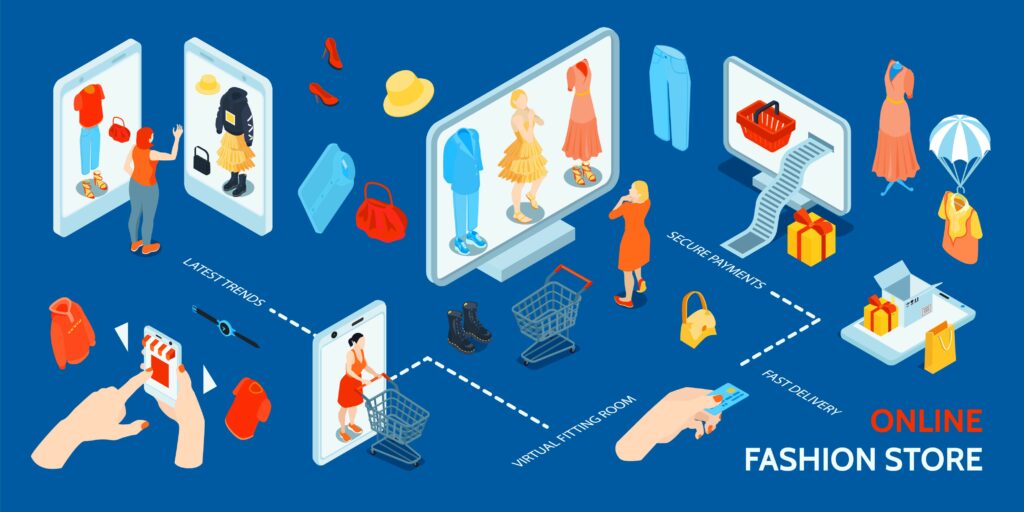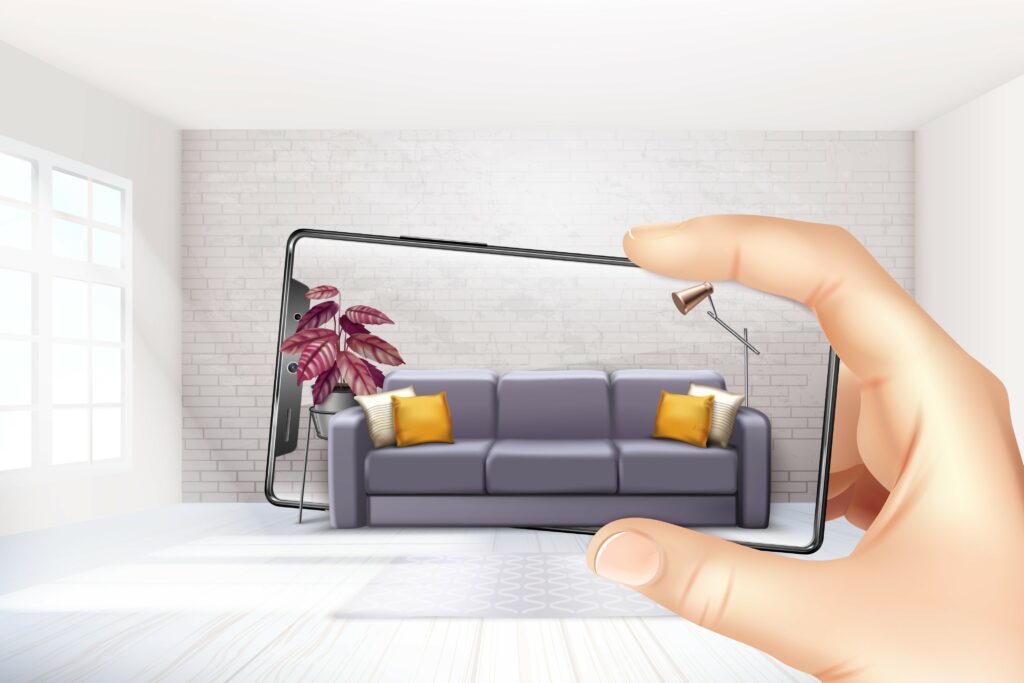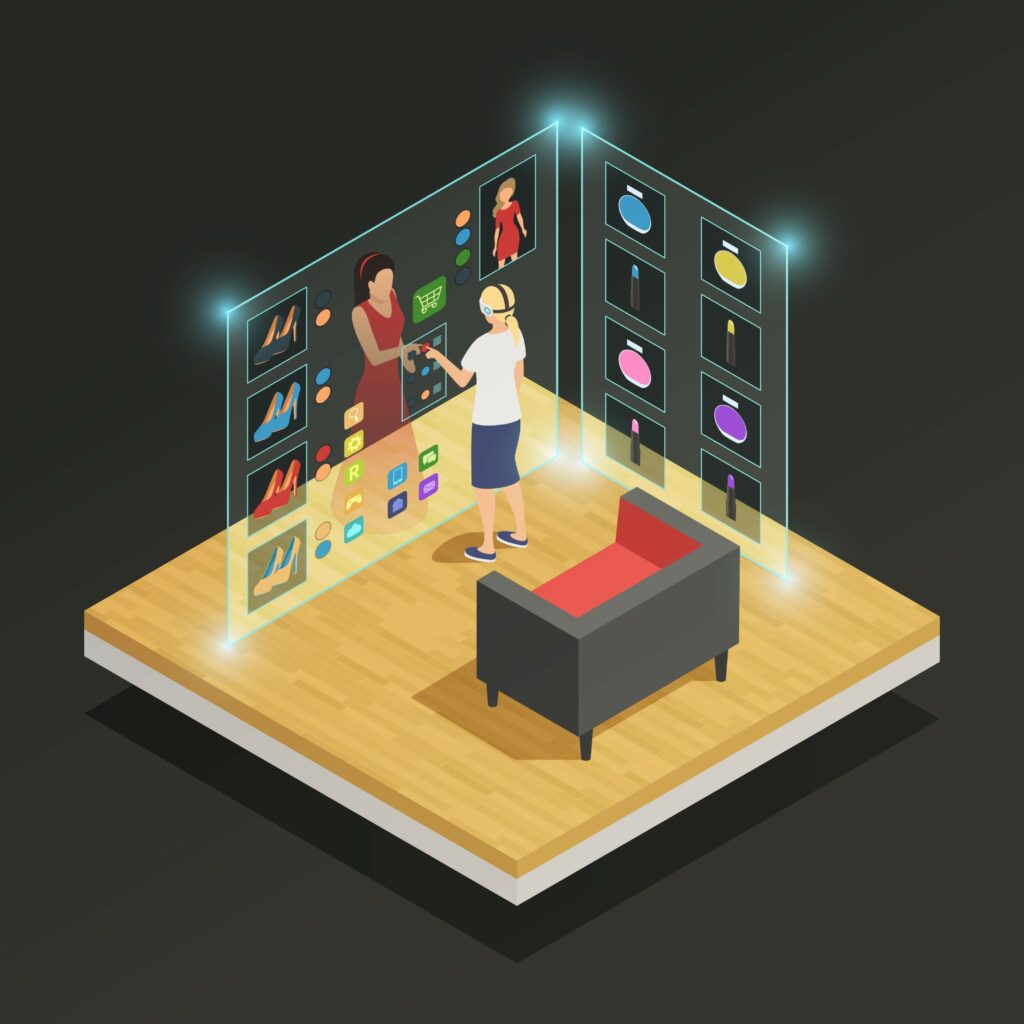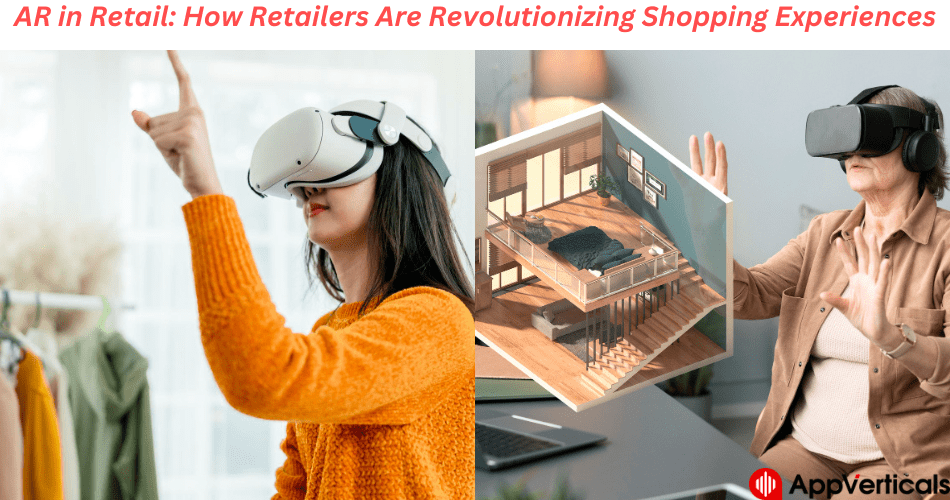AR in retail is transforming the way we shop and interact with products. It allows us to superimpose digital elements onto the real world, opening doors to unprecedented shopping experiences.
Whether you’re a curious shopper eager to learn more about “how is augmented reality used in businesses?” or a retailer wondering if “augmented reality apps for Android” can benefit your business, this blog post is for you.
So, get ready to explore the future of shopping with AR!
Augmented Reality (AR): A Peek Behind the Magic Curtain
Ever wondered how those adorable virtual creatures popped up in your local park during the Pokémon Go craze? Or how could you virtually try different hairstyles with a tap on your phone? That’s the magic of Augmented Reality (AR). It’s not just for fun and games anymore. AR is rapidly transforming various industries, and retail is at the forefront of this exciting revolution.
So, what exactly is AR?
Imagine holding your phone up to a pair of shoes in a store and seeing them magically appear on your feet, virtually showcasing how they would look. That’s AR in action. It superimposes digital elements (like 3D objects, animations, or text) onto the real world you see through your phone or tablet’s camera.
Here are some relatable examples you might already be familiar with:
- Pokémon Go: This popular game uses AR to overlay virtual creatures onto the real world, encouraging players to explore their surroundings and capture them.
- Snapchat filters: These playful filters add virtual elements like funny hats, animal ears, or even makeup effects to your selfies, allowing you to express yourself creatively.
But how does this technology actually work?
The magic behind AR involves a few key concepts:
- Overlays: Digital elements, like 3D models or text, are created and superimposed onto the real-world view captured by your device’s camera.
- Real-time interaction: These overlays are not static images but rather dynamically adjust based on your movements and the environment. For instance, the virtual shoes adjust to your foot size and position as you move your phone.
- Device integration: AR experiences rely on sensors in your smartphone or tablet, like the camera, gyroscope, and accelerometer, to track your movements and adapt the digital elements accordingly.
Now, let’s dive into the exciting world of AR in retail and explore its potential benefits:
- Enhanced product visualization: AR apps can make this possible by allowing them to virtually place a 3D model of the couch in their space, taking into account room size, lighting, and even existing furniture arrangements. This eliminates the guesswork and increases confidence in purchasing decisions.
- Personalized experiences: AR can personalize the shopping experience by tailoring product recommendations and information based on individual preferences. For example, a beauty store could use AR to recommend makeup shades based on a customer’s skin tone and suggest complementary products. This personalized approach fosters a deeper connection with customers and encourages them to explore new products.
- Improved customer engagement: AR goes beyond just viewing static product images. It allows for interactive experiences that keep customers engaged. AR makes shopping more fun and engaging, leading to increased customer satisfaction and brand loyalty.
- Increased sales and revenue: With product visualization, personalizing experiences, and boosting engagement, AR can ultimately lead to increased sales and revenue for retailers. Studies have shown that AR experiences can increase conversion rates, reduce product returns, and attract new customers.
AR in retail is a powerful tool that can revolutionize the shopping experience for both customers and businesses.
READY TO TURN YOUR AR/MOBILE APP IDEA INTO REALITY?
GET A FREE CONSULTATION WITH OUR EXPERTS TODAY!
Discuss your unique idea with usAR in Action: Exploring Use Cases Across Retail Sectors
Visualize a new couch in your living room before making the purchase. This is no longer a scene from a sci-fi movie; it’s the reality of AR in retail. Let’s delve into how different industries are leveraging this innovative technology:
Fashion & Apparel: Dressing Virtually for a Seamless Shopping Experience
AR in fashion allows customers to try on clothes virtually using their smartphones or tablets. Popular AR apps for Android and iOS, like Wannaby, utilize your phone’s camera to superimpose clothing onto your virtual image. This allows you to experiment with different styles, colors, and sizes, ensuring a perfect fit before purchasing.

Furthermore, interactive product information displays can enrich the shopping experience. Simply point your phone at a garment to access details like material composition, care instructions, and customer reviews. This empowers you to make informed decisions and purchase with confidence.
Real-world example: Clothing giant GAP launched a virtual try-on experience for its denim collection. This resulted in a 30% increase in online sales for the featured denim products, showcasing the effectiveness of AR in driving conversion rates.
Furniture & Home Decor: Decorating Virtually for Confident Purchases
Furnishing your home can be daunting, especially when visualizing how furniture pieces will fit and complement your existing décor. AR in furniture and home décor tackles this challenge by allowing you to place furniture in your own living space virtually.

Apps like Ikea Place and EQ3 allow you to scan your room using your phone and then virtually place furniture models to scale. This lets you experiment with different arrangements, assess size and scale, and ensure the chosen pieces harmonize with your existing décor.
Additionally, AR can offer personalized design suggestions based on your room dimensions and style preferences. Imagine receiving recommendations for furniture layouts, color schemes, and decorative elements, all tailored to your unique space. This simplifies the often-complex process of decorating your home and fosters a more confident buying experience.
Real-world example: A renowned Canadian furniture retailer, EQ3, saw a 112% increase in conversion rate for customers who used their AR app to visualize furniture before buying. This demonstrates the potential of AR to enhance the shopping experience and increase sales for retailers.
Beauty & Cosmetics: Experimenting Virtually for a Personalized Touch
The beauty industry is embracing AR to transform the way customers try to purchase cosmetics. Apps like Sephora Virtual Artist allows you to virtually try on different makeup shades and styles using your phone’s camera to overlay products onto your face. This eliminates the need for testers and helps you find the perfect shades that complement your unique skin tone and features.

AR can offer personalized product recommendations based on your skin type, concerns, and preferences. This personalized approach empowers you to make informed choices and reduces the risk of purchasing unsuitable products.
Additionally, AR can provide interactive tutorials that guide you through makeup application techniques. It includes step-by-step instructions on applying eyeshadow, blending foundation, or creating a flawless eyeliner look, all within the app. This empowers you to experiment with new looks and achieve professional-looking results at home.
Real-world example: L’Oreal partnered with Snapchat to launch a virtual try-on experience for its lipsticks. It sees a 150% increase in Virtual try-ons, highlighting the effectiveness of AR in driving product engagement and sales.
These are just a few examples of how AR in retail is transforming shopping experiences across various sectors. With its ability to enhance visualization, personalize recommendations, and empower informed decision-making, AR is poised to become an integral part of the future of retail. It offers both customers and businesses a more engaging and rewarding shopping experience.
The Impact of AR: Beyond Just a Gimmick
AR in retail is a powerful tool that demonstrably enhances customer satisfaction, boosts sales and revenue, and fosters deeper brand loyalty and engagement. Let’s delve into these key benefits and explore real-world examples to illustrate their tangible impact.
Customer Experience: A Seamless Journey from Curiosity to Confidence
AR tackles the frustration of buying furniture online. It allows you to virtually place furniture models in your own space, ensuring a perfect fit before purchase.
AR goes beyond visualization. Virtual try-on experiences in the fashion and beauty industries are revolutionizing the way we shop. Sephora’s Virtual Artist app, for example, allows customers to try makeup shades and styles virtually, leading to increased customer satisfaction and reduced purchase anxiety. A study by Shopify revealed that 63% of consumers are more likely to buy from a brand offering AR experiences, highlighting the significant impact on customer behavior.
Sales & Revenue: Ringing Up Success with Engaging Experiences
AR product visualizations can increase conversion rates by up to 90%. This is because AR allows customers to engage with products in a more interactive and immersive way, leading to a deeper understanding of features and benefits. Additionally, AR can encourage impulse purchases by showcasing related products or offering personalized recommendations based on your virtual try-on selections.
Furthermore, AR experiences can attract new customers seeking unique and engaging shopping experiences. Consider Warby Parker’s virtual try-on app, which allows customers to try on glasses using their smartphone camera virtually. This innovative approach has attracted a younger, tech-savvy demographic, contributing to the company’s impressive growth.
Brand Loyalty & Engagement: Building Deeper Connections
The impact of AR extends beyond immediate sales, fostering stronger brand loyalty and deeper customer engagement. By offering interactive and personalized AR experiences, brands can create a memorable and emotional connection with their customers.
For instance, the Adidas AR app allows customers to virtually “try on” shoes using their smartphone camera. This not only enhances the shopping experience but also encourages customers to share their virtual creations on social media, increasing brand awareness and engagement organically.
Getting Started with AR: A Roadmap for Retailers
So, you’re captivated by the possibilities of AR in retail and eager to leverage its potential in your own business. But where do you begin? This section acts as your roadmap to navigate the exciting journey of implementing AR and transforming your customer experience:
1. Identify Your Goals: Charting Your AR Journey
The first step is defining your objectives for incorporating AR. What specific areas do you want to address? Here are some common goals retailers pursue:
- Enhanced product visualization: Customers can virtually see how furniture fits in their homes, visualize clothing on their bodies, or explore product details interactively.
- Increased customer engagement: Provide interactive product experiences that capture customers’ attention, encourage exploration, and lead to deeper brand interaction.
- Improved purchase confidence: The buyer has no hesitation in trying products virtually, addressing sizing concerns, and making informed purchase decisions.
- Streamlined in-store experience: Customers experience a smooth experience with AR navigation, seeing product information overlays, or getting self-checkout options using AR technology.
WITH CLEAR GOALS, YOU CAN ESTABLISH A STRATEGIC DIRECTION FOR YOUR AR IMPLEMENTATION!
ENSURE YOUR CHOSEN SOLUTION ALIGNS WITH YOUR BUSINESS OBJECTIVES.
Contact-us2. Choose the Right Technology: Finding Your AR Toolkit
Now comes the exciting part – exploring AR development tools and platforms. The “right” technology depends on your unique needs, budget, and technical expertise. Here’s a breakdown of some key considerations:
- Internal development vs. partnering with AR agencies: Do you have an in-house development team capable of building an AR experience, or will you seek external expertise? Partnering with a highly recognized AR integration and app development company in Dallas is the preferred option, as they have skilled developers who can handle challenging tasks.
- Existing AR development platforms: Several platforms offer tools and frameworks to create AR experiences without extensive coding knowledge. Consider platforms like ARKit (for iOS), and ARCore (for Android) that provide development tools, tracking capabilities, and object recognition features.
- Third-party AR solutions: Pre-built AR solutions might be suitable for specific tasks, like virtual try-on experiences or product visualization tools. Evaluate these options based on their features, pricing plans, and compatibility with your existing infrastructure.
Thorough research and careful evaluation are crucial when choosing the right AR technology.
3. Develop and Implement Your AR Experience: Bringing Your Vision to Life
Once you have a clear roadmap and chosen technology, it’s time to develop and implement your AR experience. This stage involves:
- Collaboration with AR developers: Clearly communicate your vision and goals to the development team when developing augmented reality apps. Ensure everyone involved understands the desired user experience, technical requirements, and project timeline.
- Iterative development process: Start with a Minimum Viable Product (MVP), a basic version of your AR experience with core functionalities. Gather user feedback, test thoroughly, and iterate on the design and functionalities based on the collected insights.
- Seamless user experience: Prioritize a user-friendly interface, intuitive interactions, and clear instructions within your AR experience.
4. Measure & Optimize: Learning from Your AR Journey
Implementing AR is an ongoing process. Continuously measure and optimize your AR experience to ensure it delivers the desired results:
- Track key metrics: Monitor user engagement, conversion rates, customer feedback, and app store reviews to assess the effectiveness of your AR experience.
- Analyze and interpret data: Use insights from your data to identify areas for improvement. This could be refining functionalities, enhancing the user interface, or adding new features based on user feedback.
- Continuous improvement: Stay updated on the latest advancements in AR technology and explore opportunities to integrate new functionalities or adapt your experience to keep users engaged and achieve your evolving business goals.
Real-World Example: A popular AR app, Ikea Place, allows users to place Ikea furniture in their homes virtually. This app has been a game-changer, reducing purchase anxiety and boosting Ikea’s sales. By enabling customers to visualize furniture in their actual living spaces, Ikea Place has addressed a major pain point and provided a valuable service that enhances the customer experience.
By following these steps and continuously refining your approach, you can successfully implement AR and transform your retail experience, creating a competitive edge and engaging your customers in innovative ways.
AR in Retail App Showdown:
Shopping should be fun and informative, not a guessing game! Here’s a breakdown of some popular AR retail apps to transform your shopping experience:
| Feature | Amazon Shopping App | Ikea Place | Sephora Virtual Artist | YouCam Makeup |
| Platform Availability | iOS, Android | iOS, Android | iOS, Android | iOS, Android |
| Hero Feature | Virtual product placement in your home | See furniture in your space to scale & style | Virtually try on makeup looks | Experiment with makeup virtually |
| Best for | Visualizing furniture & home decor | Planning & decorating your living space | Trying on makeup before you buy | Experimenting with different makeup styles |
| Additional Features | Product scanning for reviews & info | 360° product views & assembly instructions | Skin analysis & shade recommendations | Step-by-step makeup tutorials |
| Potential Drawbacks | Limited furniture selection | May require good lighting for accurate placement | Limited brand selection for makeup | Not a perfect substitute for trying on makeup in person |
A Glimpse into the Advantages of AR
Let’s revisit the key advantages of AR that are reshaping the retail landscape:
- Enhanced Product Visualization: AR empowers customers to virtually experience products before making a purchase. This eliminates guesswork and boosts confidence in purchase decisions.
- Personalized Experiences: AR personalizes the shopping journey by offering tailored recommendations, interactive product information overlays, and even gamified experiences. This fosters a deeper connection with customers, enhances brand loyalty, and keeps them engaged throughout their shopping journey.
- Improved Customer Engagement: From engaging product demonstrations to interactive games and virtual tours, AR injects a dose of excitement and interactivity into the shopping experience. This keeps customers captivated, increases dwell time and ultimately leads to higher conversion rates.
It’s Shiny, But Are There Any Hiccups? Challenges of Implementing AR in Retail
Augmented reality (AR) is revolutionizing retail, but let’s be real, no new tech is perfect. Here’s a breakdown of some potential challenges to consider when diving into the world of AR shopping:
| Challenge | Impact on You (the Shopper) | Solutions |
| Limited App Selection & Device Compatibility | You might not find an AR app for your favorite store or your phone might not be compatible. | Research AR capabilities of your favorite stores and consider upgrading if necessary (but only if it fits your budget!). |
| Tech Glitches & Inaccurate Placements | Jumpy furniture in your living room or makeup shades that look off can be frustrating. | Be patient, technology is evolving! Most apps offer troubleshooting tips and updates to improve accuracy. |
| Privacy Concerns | Sharing location data or facial scans might raise privacy red flags. | Check app privacy policies and adjust settings if needed. Remember, you’re always in control of your data. |
| High-Tech Learning Curve | Not everyone is tech-savvy, and navigating AR apps might feel overwhelming. | Most apps offer user-friendly interfaces and tutorials. Don’t be afraid to ask store staff for help! |
| Limited Product Availability | Not everything might be available in AR yet. That dream couch you saw online might not show up in the app. | Be patient, the AR retail world is expanding rapidly. The selection of AR-compatible products will likely increase over time. |
Future Outlook: Where is AR in Retail Headed?
The future of AR in retail is brimming with exciting possibilities. Here are some key trends to watch:
- Advanced AR experiences: Expect to see more sophisticated and immersive AR experiences, blurring the lines between the physical and digital worlds even further. With AR integration, you can virtually try on clothes specific to body measurements or experience furniture in your home with lighting and shadows that mimic real-life scenarios.
- Integration with Artificial Intelligence (AI): The fusion of AR and AI holds immense potential. AI-powered virtual assistants guide customers through product selection via personalized recommendations or offer styling advice based on their preferences.
- Widespread adoption of AR apps: As AR technology becomes more accessible and affordable, expect to see a wider range of AR apps available for both businesses and consumers. This will further empower retailers of all sizes to leverage this technology and connect with their customers in new and innovative ways.
Wrapping it Up!
Don’t wait any longer! Delve deeper into the world of “augmented reality apps for Android” or other relevant platforms. By taking the first step towards implementing AR, you can unlock its potential and revolutionize the way your customers experience your brand.
Need More Help? Contact AppVerticals!








